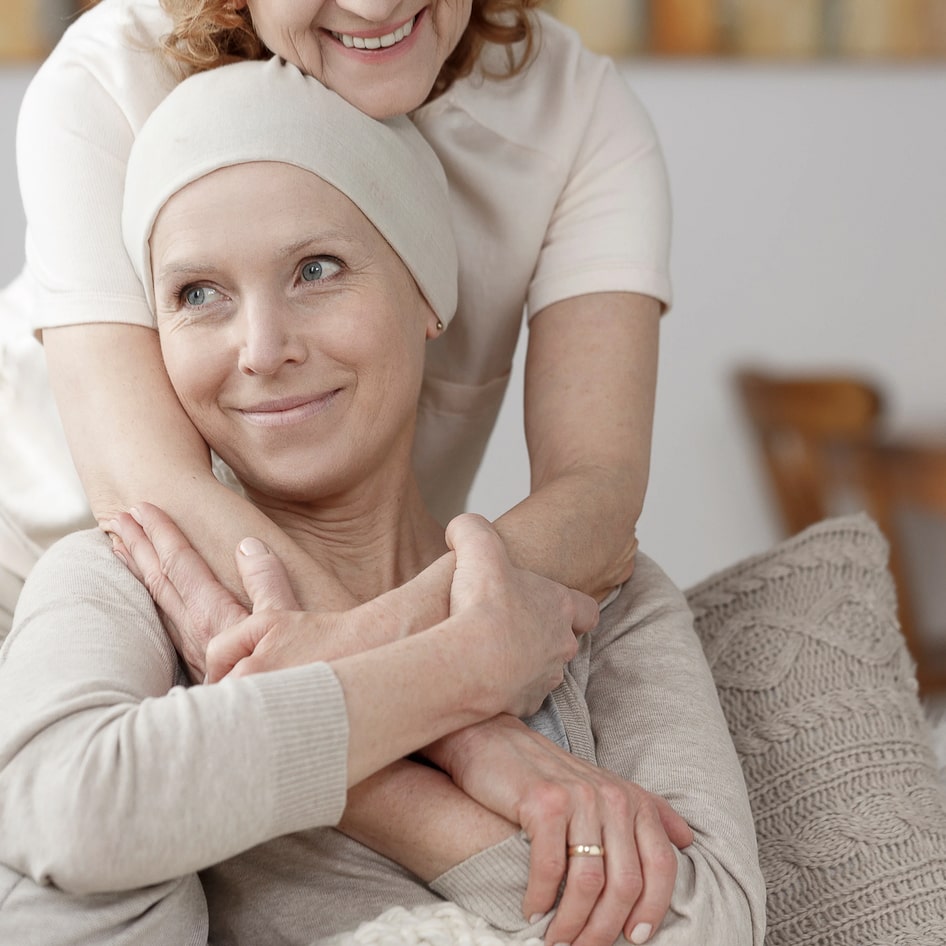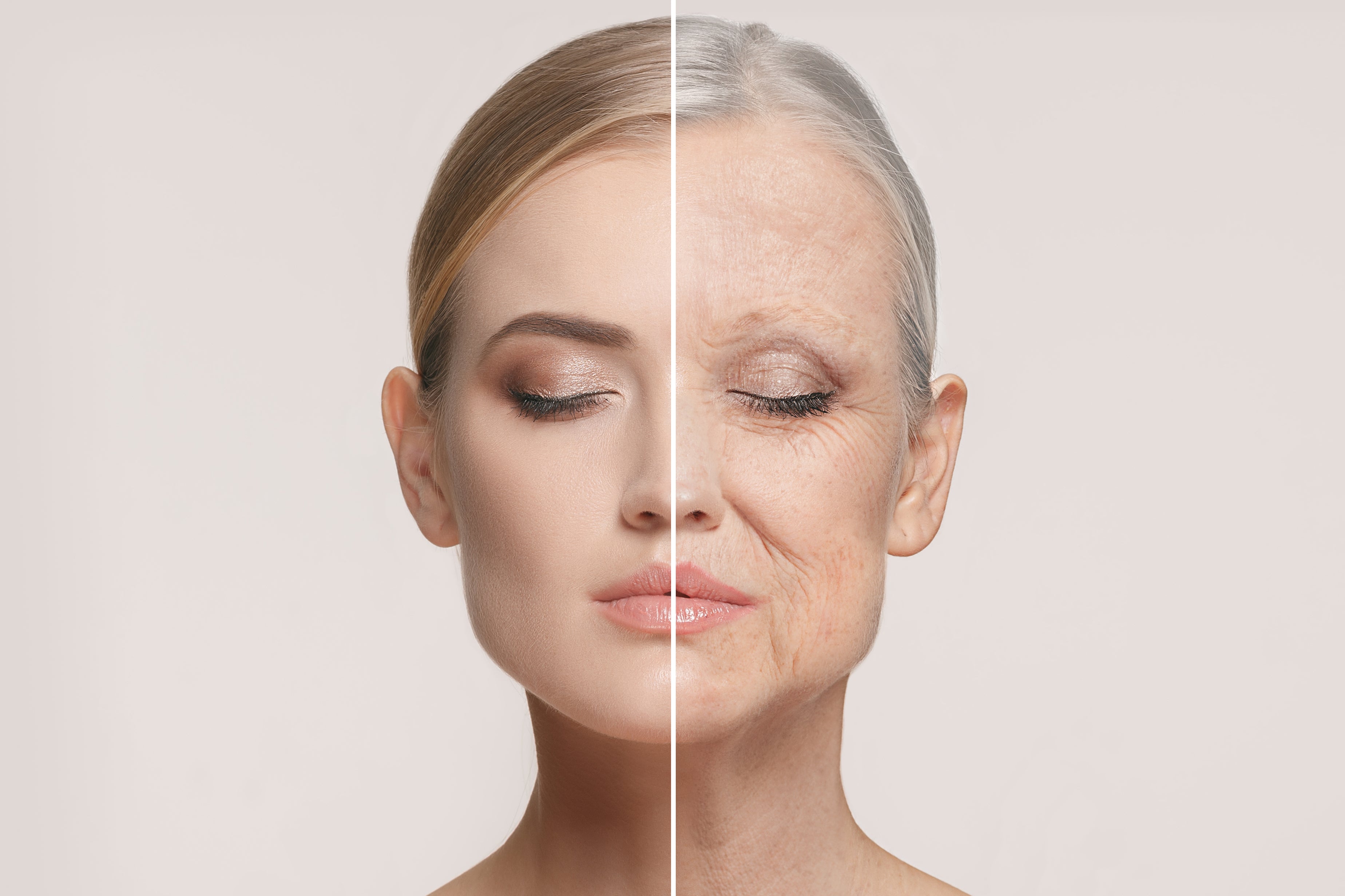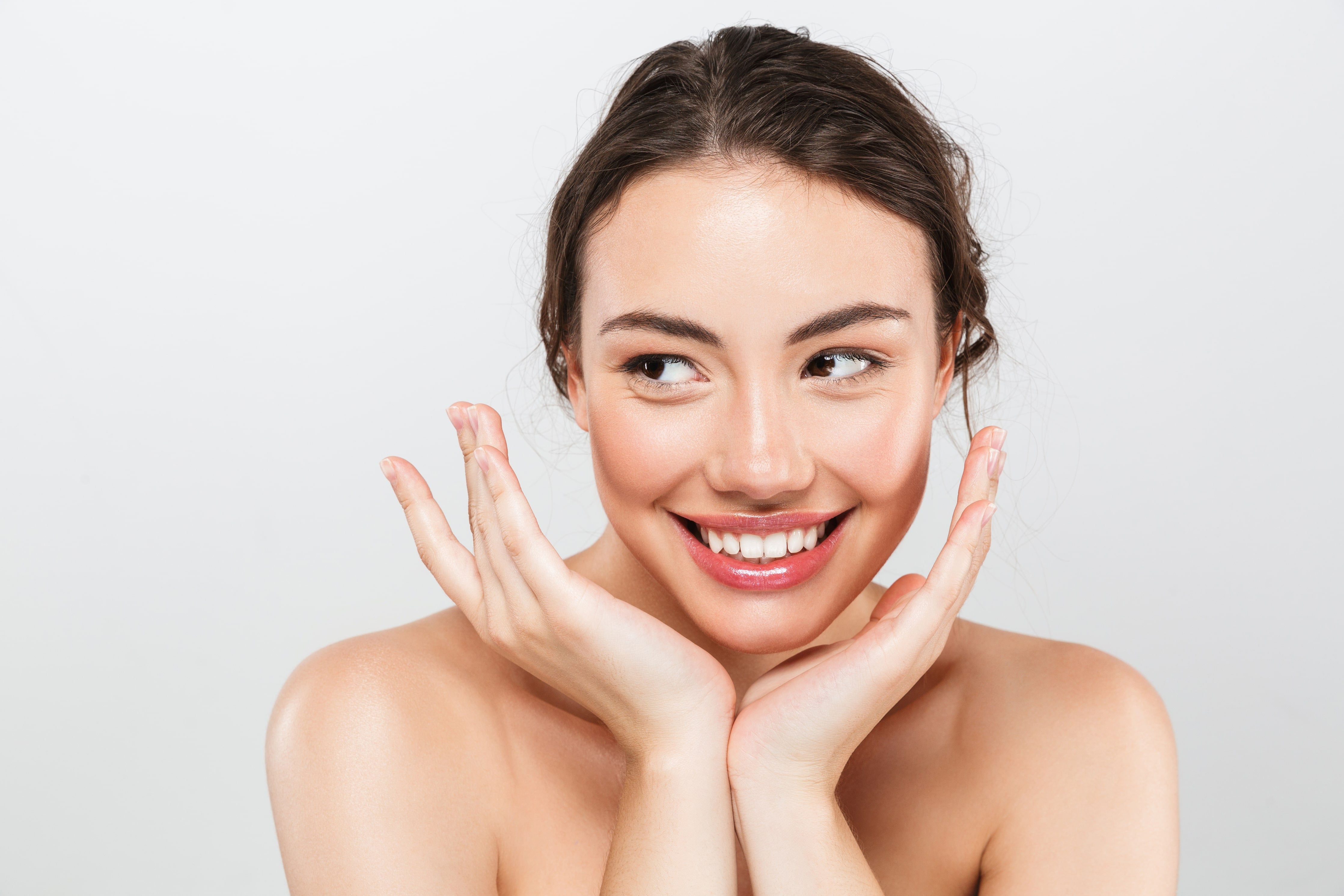Understanding Skin Aging
Human skin consists of 4 major layers, three of which are shown in the “Young Skin” cartoon shown below. These are: 1) the topmost barrier layer (or stratum corneum) which protects the skin from invading organisms and from water loss, 2) the epidermis which contains keratinocytes that rebuild the barrier layer, and melanocytes (at the base of the epidemis), which produce melanin, the brown pigment we refer to as a “tan”, and 3) the dermis, which is home to fibroblasts, the cells that produce the skin’s “matrix” composed of collagen, elastin, hyaluronic acid. The dermal matrix gives the skin its elasticity, strength, thickness, and suppleness. The fourth layer(not shown) is the subdermal area consisting primarily of fat cells.

Research has shown that there are two distinct types of aging. Aging caused by the genes we inherit is called INTRINSIC AGING (internal/chronological aging). The other type of aging is known as EXTRINSIC AGING (external aging) and is caused by environmental factors, such as exposure to the sun’s rays. Since exposure to sunlight over many years causes most of the extrinsic aging to the skin, the term “photoaging” is often used to describe the effects of UV radiation from the sun on skin aging.
INTRINSIC AGING
Intrinsic aging, also known as “chronological aging” or “natural aging”, is a continuous process that normally begins in our mid-20s. As we age, our skin alters its functioning to switch from one characterized by skin matrix “building” to one of skin matrix “eroding”. As dermal fibroblasts begin to age, they produce decreasing amounts of collagen and elastin. While this would be enough to reduce the skin’s strength and elasticity, aging fibroblasts also begin to produce increased amounts of enzymes called matrix metalloproteinases (MMP’s), which act to degrade existing collagen and elastin. So not only is collagen production decreasing with age, its destruction is increasing! As the skin aging process proceeds, the dermal fibroblasts go into a state of senescence at which point they stop dividing. Because older fibroblasts don’t reproduce, the number of fibroblasts in the skin declines, and the skin thins. Further, the synthesis of hyaluronic acid and other sugar polymers (Glycosaminoglycans) decreases, thereby further thinning the skin and reducing its water retention properties. The stratum corneum becomes damaged and breaks occur, causing water loss.
Finally, an additional event that occurs during aging is a slow increase in skin inflammation, referred to as "smoldering inflammation". Immune cells are inappropriately recruited into the skin where they produce and release a variety of inflammatory hormone-like mediators (called cytokines and chemokines). These mediators can cause a further loss of collagen and further deterioration of the skin. A few of the visible signs of skin aging are:
- Fine wrinkles on face and hands
- Thin and transparent skin
- Loss of underlying fat, leading to hollowed cheeks and eye sockets as well as noticeable loss of firmness on the hands and neck
- Dry skin that may crack and itch
EXTRINSIC AGING (Photoaging)
In extrinsic aging, external factors often act together with the normal aging process to prematurely age our skin. For those who spend a lot of time in the sun, the skin aging process is dramatically accelerated with damage to the dermal matrix occurring in young people in their 30s and even 20s. Most dermatologists agree that no amount of sun exposure is good for the skin. While most premature aging is caused by sun exposure, other external factors, such as smoking and environmental pollutants can also prematurely age the skin. These external factors cause many of the same aging effects as natural, chronological aging, but do so in an accelerated fashion. As a result, the skin of a middle aged person who has spent years in the sun, will have the physical appearance of a person in their late 70s.
Without protection from the sun’s rays, just a few minutes of exposure each day over many years can cause noticeable changes to the skin. Long term sun exposure results in freckles, age spots (solar lentigines), spider veins on the face, rough and leathery skin, actinic keratoses (solar keratoses), fine wrinkles that disappear when stretched, loose skin, and a blotchy complexion. More seriously, skin cancer is largely caused by sun exposure.
“Photoaging” is the term dermatologists use to describe this type of aging caused by exposure to the sun’s rays. The amount of photoaging that develops depends on: 1) a person’s skin color and 2) their history of long-term or intense sun exposure. People with fair skin who have a history of sun exposure develop more severe signs of photoaging than those with dark skin. In the darkest skin, the signs of photoaging are minimal and usually limited to fine wrinkles and a mottled complexion. The long-term effects of photoaging occur over a period of years, but even very short exposures to the UV radiation of the sun can cause skin “aging” effects. In fact, studies have shown that just a 15 minute exposure of skin fibroblasts to the summertime sun in the southwest part of the country can rapidly reduce collagen synthesis by up to 70%. And although collagen production will resume when the skin is removed from the sun, the recovery process takes many hours. With repeated exposure to the sun over many years, the skin loses the ability to make collagen, or to repair itself, and the damage accumulates. Scientific studies have shown that not only does repeated exposure to ultraviolet (UV) rays of the sun impair the synthesis of new collagen, but the UV radiation triggers an inflammatory response that result in the increased production of MMP (matrix metalloproteinases) enzymes that break down collagen, elastin, and other matrix components.
Unlike intrinsic (chronological aging), photoaging causes an abnormal increase in elastin production, organization and deposition that results in the skin appearing yellow and thickened with bumps or furrowing .This condition is referred to as solar elastosis. Due to the loss of collagen and changes to the organization of elastin, sun-weakened skin ceases to spring back compared to skin protected from UV rays. As a result of prolonged sun exposure without sunscreen protection, the skin becomes loose, wrinkled, and leathery at a fairly young age.
MAINTAINING A HEALTHY, YOUTHFUL SKIN
Although skin aging is a fact of life, there are certainly steps that one can take to slow down the aging process. Obviously, protecting your skin from the harmful effects of the UV rays of the sun by using sunscreens is a MUST if you want to maintain a youthful appearance and prevent sun-related skin problems, including skin cancer. In addition, since inflammation plays a significant role in the skin aging process, it is important to use skin care products that can address this aging event. Much of the inflammation that occurs in the skin is caused by free radicals that are produced in response to sun exposure and to environmental pollutants. In addition, smoking triggers the production of free radicals, which is another reason for eliminating this habit. And, unfortunately, as we age, our body and skin just naturally produce higher levels of free radicals that trigger ongoing “smoldering inflammation” This inflammation occurs all day, every day, and the inflammatory mediators produced in response to free radicals stress and damage the skin. Using skin care products that contain powerful antioxidants that can block and inactivate free radicals is an important step to take to protect your skin, and slow the aging process. All DermaMedics products contain the Company’s patented and potent “super antioxidants”.






